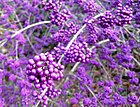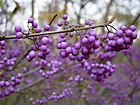Note: This is a project under development. The articles on this wiki are just being initiated and broadly incomplete. You can Help creating new pages.
Difference between revisions of "Callicarpa - Gandhaphala"
| Line 1: | Line 1: | ||
[[File:Callicarpa-bodinieri-flowers.jpg|thumb|right|''Callicarpa'', ''Gandhaphala'']] | [[File:Callicarpa-bodinieri-flowers.jpg|thumb|right|''Callicarpa'', ''Gandhaphala'']] | ||
| − | |||
'''Gandhaphala''' (Callicarpa) is a genus of shrubs and small trees in the family Lamiaceae. They are native to east and southeast Asia (where the majority of the species occur), Australia, Madagascar, southeast North America and South America. It is also known as '''Callicarpa, Gandha Priyangu, Priyangu and many more. | '''Gandhaphala''' (Callicarpa) is a genus of shrubs and small trees in the family Lamiaceae. They are native to east and southeast Asia (where the majority of the species occur), Australia, Madagascar, southeast North America and South America. It is also known as '''Callicarpa, Gandha Priyangu, Priyangu and many more. | ||
==Uses== | ==Uses== | ||
| − | {{Uses|Sudorific}}, {{Uses| | + | {{Uses|Sudorific}}, {{Uses|Wound}}, {{Uses|Ulcers}}, {{Uses|Gum bleeding}}, {{Uses|Therapeutic smoking}}. |
==Parts Used== | ==Parts Used== | ||
| − | {{Parts Used|Flower bud}}, {{Parts Used| | + | {{Parts Used|Flower bud}}, {{Parts Used|Seed}}. |
==Chemical Composition== | ==Chemical Composition== | ||
| Line 13: | Line 12: | ||
==Common names== | ==Common names== | ||
| − | {{Common names|kn=Rushipatri|ml=Chimpompil, | + | {{Common names|kn=Rushipatri|ml=Chimpompil, Chinpompil|sa=Priyangu|ta=Kattu-k-kumil|te=|hi=Bastara|en=Beauty Berry}} |
==Properties== | ==Properties== | ||
| Line 57: | Line 56: | ||
==Commonly seen growing in areas== | ==Commonly seen growing in areas== | ||
| − | {{Commonly seen| | + | {{Commonly seen|Well-drained soil}}, {{Commonly seen|Partial shade}}. |
==Photo Gallery== | ==Photo Gallery== | ||
Revision as of 17:13, 30 September 2018
Gandhaphala (Callicarpa) is a genus of shrubs and small trees in the family Lamiaceae. They are native to east and southeast Asia (where the majority of the species occur), Australia, Madagascar, southeast North America and South America. It is also known as Callicarpa, Gandha Priyangu, Priyangu and many more.
Contents
- 1 Uses
- 2 Parts Used
- 3 Chemical Composition
- 4 Common names
- 5 Properties
- 6 Habit
- 7 Identification
- 8 List of Ayurvedic medicine in which the herb is used
- 9 Where to get the saplings
- 10 Mode of Propagation
- 11 How to plant/cultivate
- 12 Commonly seen growing in areas
- 13 Photo Gallery
- 14 References
- 15 External Links
Uses
Sudorific, Wound, Ulcers, Gum bleeding, Therapeutic smoking.
Parts Used
Chemical Composition
alpha-amyrin(I), 2beta, 3beta, 19alpha-trihydroxy-12-en-28-ursolic acid (II), oleanolic aicd (III), alpha-amyrin-3-0-beta-D-glucopyranoside (IV), ursolic acid (V), betulinic acid[1]
Common names
| Language | Common name |
|---|---|
| Kannada | Rushipatri |
| Hindi | Bastara |
| Malayalam | Chimpompil, Chinpompil |
| Tamil | Kattu-k-kumil |
| Telugu | |
| Marathi | NA |
| Gujarathi | NA |
| Punjabi | NA |
| Kashmiri | NA |
| Sanskrit | Priyangu |
| English | Beauty Berry |
Properties
Reference: Dravya - Substance, Rasa - Taste, Guna - Qualities, Veerya - Potency, Vipaka - Post-digesion effect, Karma - Pharmacological activity, Prabhava - Therepeutics.
Dravya
Rasa
Tikta (Bitter), Kashaya (Astringent), Madhura (Sweet)
Guna
Laghu (Light), Ruksha (Dry)
Veerya
Sheeta (Cold)
Vipaka
Katu (Pungent)
Karma
Kapha, Vata, Pitta
Prabhava
Habit
Identification
Leaf
| Kind | Shape | Feature |
|---|---|---|
| Simple | Deciduous | Leaf Arrangement is Opposite and Leaf Complexity is Simple, Leaf Shape: Elliptic , Ovate |
Flower
| Type | Size | Color and composition | Stamen | More information |
|---|---|---|---|---|
| Unisexual | 2-4cm long | Stamens exserted | Flowers Season is June - August |
Fruit
| Type | Size | Mass | Appearance | Seeds | More information |
|---|---|---|---|---|---|
| Drupe | 3-6 ft | Fruit colour is Purple, sometimes white.clearly grooved lengthwise, Lowest hooked hairs aligned towards crown | many | {{{6}}} |
Other features
List of Ayurvedic medicine in which the herb is used
- Vishatinduka Taila as root juice extract
Where to get the saplings
Mode of Propagation
How to plant/cultivate
Easily grown in average, medium moisture, well-drained soil in full sun to part shade[3]
Commonly seen growing in areas
Well-drained soil, Partial shade.
Photo Gallery
References
External Links
- Ayurvedic Herbs known to be helpful to treat Sudorific
- Ayurvedic Herbs known to be helpful to treat Wound
- Ayurvedic Herbs known to be helpful to treat Ulcers
- Ayurvedic Herbs known to be helpful to treat Gum bleeding
- Ayurvedic Herbs known to be helpful to treat Therapeutic smoking
- Herbs with Flower bud used in medicine
- Herbs with Seed used in medicine
- Herbs with common name in Kannada
- Herbs with common name in Hindi
- Herbs with common name in Malayalam
- Herbs with common name in Tamil
- Herbs with common name in Sanskrit
- Herbs with common name in English
- Habit - Shrub
- Index of Plants which can be propagated by Seeds
- Index of Plants which can be propagated by Cuttings
- Herbs that are commonly seen in the region of Well-drained soil
- Herbs that are commonly seen in the region of Partial shade
- Herbs








